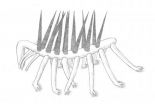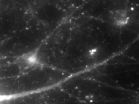(Press-News.org) A team led by researchers at the University of Exeter Medical School and King's College London has uncovered some of the strongest evidence yet that epigenetic changes in the brain play a role in Alzheimer's disease.
Epigenetic changes affect the expression or activity of genes without changing the underlying DNA sequence and are believed to be one mechanism by which the environment can interact with the genome. Importantly, epigenetic changes are potentially reversible and may therefore provide targets for the development of new therapies.
Globally, more than 26 million people are currently affected by Alzheimer's Disease. As this number grows in line with an increasingly aging population, the need to identify new disease mechanisms is more important than ever. Post-mortem examinations have revealed much about how Alzheimer's damages the brain, with some regions, such as the entorhinal cortex, being particularly susceptible, while others, such as the cerebellum, remain virtually unscathed. However, little is yet known about how and why the disease develops in specific brain regions.
The current study found that chemical modifications to DNA within the ANK1 gene are strongly associated with measures of neuropathology in the brain. The study, published in Nature Neuroscience, found that people with more Alzheimer's disease-related neuropathology in their brains had higher levels of DNA modifications within the ANK1 gene. The finding was particularly strong in the entorhinal cortex, and also detected in other cortical regions affected by the disease. In contrast, no significant changes were observed in less affected brain regions or blood.
Professor Jonathan Mill, of the University of Exeter Medical School and King's College London, who headed the study, said: "This is the strongest evidence yet to suggest that epigenetic changes in the brain occur in Alzheimer's disease, and offers potential hope for understanding the mechanisms involved in the onset of dementia. We don't yet know why these changes occur – it's possible that they are involved in disease onset, but they may also reflect changes induced by the disease itself."
Dr Katie Lunnon, first author on the study, from the University of Exeter Medical School, added: "It's intriguing that we find changes specifically in the regions of the brain involved in Alzheimer's disease. Future studies will focus on isolating different cell-types from the brain to see whether these changes are neuron-specific."
Dr Simon Ridley, Head of Research at Alzheimer's Research UK, the UK's leading dementia research charity, who also provided funding for the study said:
"We know that changes to the DNA code of certain genes are associated with an increased risk of developing Alzheimer's disease. Investigating how epigenetic changes influence genes in Alzheimer's is still a relatively new area of study. The importance of understanding this area of research is highlighted by the fact that epigenetic changes have been associated with development of other diseases, including cancer.
"This innovative research has discovered a potential new mechanism involved in Alzheimer's by linking the ANK1 gene to the disease. We will be interested to see further research into the role of ANK1 in Alzheimer's and whether other epigenetic changes may be involved in the disease."
"Alzheimer's affects millions of people worldwide and we need pioneering research to understand exactly why the disease occurs. Alzheimer's Research UK is helping to fund research which will take us a step closer to understanding and defeating this devastating disease."
INFORMATION:
In addition to the University of Exeter Medical School and King's College London, the team included contributors from The Icahn School of Medicine at Mount Sinai, the JJ Peters VA Medical Center, The Johns Hopkins University School of Medicine, Harvard Medical School, the University of Oxford, and Rush University Medical Center, Chicago. They used cutting-edge technology to examine brain tissue from different areas of the brain across three cohorts - the MRC London Brain Bank for Neurodegenerative Disease, the Oxford Thomas Willis Brain Bank, and the Mount Sinai Alzheimer's Disease and Schizophrenia Brain Bank. They analysed three cortical regions, cerebellum, and blood obtained from several hundred individuals representing the spectrum of disease; from those with no evidence of dementia and neurodegeneration, through to patients with very advanced disease.
The research was primarily funded by the National Institutes of Health (NIH), U.S. Department of Health and Human Services, as part of its Epigenomics Roadmap Initiative (grant number R01-AG036039 awarded to Jonathan Mill). To learn more about the NIH initiative that seeks to accelerate research into the relatively new and fast-developing area of epigenetics, go to: https://commonfund.nih.gov/epigenomics/index.
. END
Epigenetic breakthrough bolsters understanding of Alzheimer's disease
A team led by researchers at the University of Exeter Medical School and King's College London has uncovered some of the strongest evidence yet that epigenetic changes in the brain play a role in Alzheimer's disease
2014-08-17
ELSE PRESS RELEASES FROM THIS DATE:
8,000-year-old mutation key to human life at high altitudes
2014-08-17
(SALT LAKE CITY) – In an environment where others struggle to survive, Tibetans thrive in the thin air on the Tibetan Plateau, with an average elevation of 14,800 feet. A study led by University of Utah scientists is the first to find a genetic cause for the adaptation – a single DNA base pair change that dates back 8,000 years – and demonstrate how it contributes to the Tibetans' ability to live in low oxygen conditions. The study appears online in the journal Nature Genetics on Aug. 17, 2014.
"These findings help us understand the unique aspects of Tibetan adaptation ...
Microchip reveals how tumor cells transition to invasion
2014-08-17
VIDEO:
Cancer cells advance across a microchip designed to be an obstacle course for cells. The device sheds new light on how cancer cells invade and could be used to test...
Click here for more information.
PROVIDENCE, R.I. [Brown University] — Using a microengineered device that acts as an obstacle course for cells, researchers have shed new light on a cellular metamorphosis thought to play a role in tumor cell invasion throughout the body.
The epithelial-mesenchymal transition ...
'Cavity protection effect' helps to conserve quantum information
2014-08-17
The electronics we use for our computers only knows two different states: zero or one. Quantum systems on the other hand can be in different states at once, they can store a superposition of "zero" and "one". This phenomenon could be used to build ultrafast quantum computers, but there are several technological obstacles that have to be overcome first. The biggest problem is that quantum states are quickly destroyed due to interactions with the environment. At TU Wien (Vienna), scientists have now succeeded in using a protection effect to enhance the stability of a particularly ...
FDA-approved drug restores hair in patients with Alopecia Areata
2014-08-17
NEW YORK, NY (August 17, 2014) —Researchers at Columbia University Medical Center (CUMC) have identified the immune cells responsible for destroying hair follicles in people with alopecia areata, a common autoimmune disease that causes hair loss, and have tested an FDA-approved drug that eliminated these immune cells and restored hair growth in a small number of patients.
The results appear in today's online issue of Nature Medicine.
In the paper, the researchers report initial results from an ongoing clinical trial of the drug, which has produced complete hair regrowth ...
Fascinating rhythm: Light pulses illuminate a rare black hole
2014-08-17
The universe has so many black holes that it's impossible to count them all. There may be 100 million of these intriguing astral objects in our galaxy alone. Nearly all black holes fall into one of two classes: big, and colossal. Astronomers know that black holes ranging from about 10 times to 100 times the mass of our sun are the remnants of dying stars, and that supermassive black holes, more than a million times the mass of the sun, inhabit the centers of most galaxies.
But scattered across the universe like oases in a desert are a few apparent black holes of a more ...
A shift in the code: New method reveals hidden genetic landscape
2014-08-17
Cold Spring Harbor, NY – With three billion letters in the human genome, it seems hard to believe that adding a DNA base here or removing a DNA base there could have much of an effect on our health. In fact, such insertions and deletions can dramatically alter biological function, leading to diseases from autism to cancer. Still, it is has been difficult to detect these mutations. Now, a team of scientists at Cold Spring Harbor Laboratory (CSHL) has devised a new way to analyze genome sequences that pinpoints so-called insertion and deletion mutations (known as "indels") ...
New home for an 'evolutionary misfit'
2014-08-17
One of the most bizarre-looking fossils ever found - a worm-like creature with legs, spikes and a head difficult to distinguish from its tail – has found its place in the evolutionary Tree of Life, definitively linking it with a group of modern animals for the first time.
The animal, known as Hallucigenia due to its otherworldly appearance, had been considered an 'evolutionary misfit' as it was not clear how it related to modern animal groups. Researchers from the University of Cambridge have discovered an important link with modern velvet worms, also known as onychophorans, ...
Stem cells reveal how illness-linked genetic variation affects neurons
2014-08-17
VIDEO:
Human neurons firing
Click here for more information.
A genetic variation linked to schizophrenia, bipolar disorder and severe depression wreaks havoc on connections among neurons in the developing brain, a team of researchers reports. The study, led by Guo-li Ming, M.D., Ph.D., and Hongjun Song, Ph.D., of the Johns Hopkins University School of Medicine and described online Aug. 17 in the journal Nature, used stem cells generated from people with and without mental illness ...
New Stanford research sheds light on how children's brains memorize facts
2014-08-17
As children learn basic arithmetic, they gradually switch from solving problems by counting on their fingers to pulling facts from memory. The shift comes more easily for some kids than for others, but no one knows why.
Now, new brain-imaging research gives the first evidence drawn from a longitudinal study to explain how the brain reorganizes itself as children learn math facts. A precisely orchestrated group of brain changes, many involving the memory center known as the hippocampus, are essential to the transformation, according to a study from the Stanford University ...
Suspect gene corrupts neural connections
2014-08-17
Researchers have long suspected that major mental disorders are genetically-rooted diseases of synapses – the connections between neurons. Now, investigators supported in part by the National Institutes of Health have demonstrated in patients' cells how a rare mutation in a suspect gene disrupts the turning on and off of dozens of other genes underlying these connections.
"Our results illustrate how genetic risk, abnormal brain development and synapse dysfunction can corrupt brain circuitry at the cellular level in complex psychiatric disorders," explained Hongjun Song, ...
LAST 30 PRESS RELEASES:
iPS cells from dish to freezer and back
Deep neural networks enable accurate pricing of American options under stochastic volatility
Collective risk resonance in Chinese stock sectors uncovered through higher-order network analysis
Does CPU impact systemic risk contributions of Chinese sectors? Evidence from mixed frequency methods with asymmetric tail long memory
General intelligence framework to predict virus adaptation based on a genome language model
Antibiotic resistance is ancient, ecological, and deeply connected to human activity, new review shows
Vapes, pouches, heated tobacco, shisha, cigarettes: nicotine in all forms is toxic to the heart and blood vessels
From powder to planet: University of Modena engineers forge a low-carbon future for advanced metal manufacturing
Super strain-resistant superconductors
Pre-school health programme does not improve children’s diet or physical activity, prompting call for policy changes, study finds
Autumn clock change linked to reduction in certain health conditions
AI images of doctors can exaggerate and reinforce existing stereotypes
Where medicine meets melody – how lullabies help babies and parents in intensive care
We may never be able to tell if AI becomes conscious, argues philosopher
AI video translation shows promise but humans still hold the edge
Deep ocean earthquakes drive Southern Ocean’s massive phytoplankton blooms, study finds
Without campus leftovers to pick through, the beaks of this bird changed shape during the pandemic
High-dose antibiotic does not reduce mortality in tuberculous meningitis
How many insects fly in the sky above the USA?
Could cheese protect your brain health?
Who faces more difficulty recovering from stroke?
Colliding galaxies create the brightest, fastest growing black holes at their center
New BrainHealth research reveals tradeoffs on sleep with cannabis use for chronic pain
Aging-US now on ResearchGate, enhancing visibility for authors and readers
'Molecular glue' stabilizes protein that inhibits development of non-small cell lung cancer
Mount Sinai Health System is recognized in 2025 Chime Digital Health Most Wired survey
From prey to predator: How carnivores spread beneficial fungi
Menopause symptoms may be frequent and have negative effects, according to female endurance athletes
US Congressmembers’ responses on X to mass shooting events differ along party lines
KAIST-UEL team develops “origami” airless wheel to explore lunar caves
[Press-News.org] Epigenetic breakthrough bolsters understanding of Alzheimer's diseaseA team led by researchers at the University of Exeter Medical School and King's College London has uncovered some of the strongest evidence yet that epigenetic changes in the brain play a role in Alzheimer's disease








